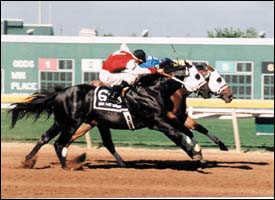
Quarter Horse Racing

Since "flat
racing" usually refers to the "sport of kings" and Thoroughbreds,
I decided to make a separate page for Quarter Horse racing.
________________________________________________________________________________________
In 1949, crowds at the Bay Meadows race track in San Mateo, California, were
introduced to Quarter Horse races as preliminary events to the running of the Thoroughbreds. Purses were only a few hundred dollars and distances were
330 to 440 yards. But the brief, blistering runs and the photo-finishes
were a new kind of excitement to most racing fans, and the sport quickly caught
on: Contrast the 8,722 recognized Quarter Horse races run in 1972 with the
25 recognized in 1945. The total of purses in 1972 was $13,578,188.
In fact, the richest purse in all racing has for years gone to the winner of a
Quarter Horse event, the All American Futurity. In 1973, it was
$1,000,000. For a horse of All American caliber, purchase price may exceed
$120,000.
Thrilling finishes, the feature that has given Quarter Horse
racing its great success, are guaranteed by a tightly organized system of
classification. Each horse is graded according to its track time and is
placed in a division with horses of similar speed. First rank
classification is AAA, for which qualifying times are 12.1 seconds for 220
yards, 13.6 for 250, 15.9 for 300, 17.3 for 330, 18.3 for 350, 20.6 for 400, and
22.5 for 440. Divisions continue through AA, A, and on to the
lowest--D--where comparable times are 13.1 seconds for 220 yards, and 24.2
seconds for 440 yards.